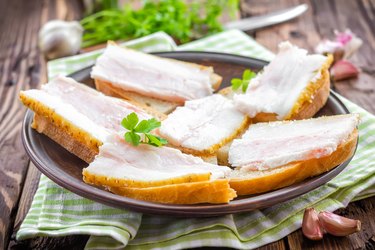
Modern-day marketing often focuses on the leanest cuts of pork, but it's the fatty cuts that are cherished in traditional cookery. An example is fatback, a thick layer cut from the area above the hog's loin. You can purchase it fresh or salted, with or without a thick strip of back bacon at the bottom; each version has its own uses in the culinary canon.
The Flavor Factory
Video of the Day
Both fresh and salted fatback meat are often used as flavoring ingredients in dishes that cook for a long time, in which even a small quantity lends a rich, porky note to the entire dish. This frugal old-school approach coaxes the maximum mileage from the inexpensive pork, so it's common in traditional blue-collar comfort foods. Use it as the pork in your New England-style pork and beans or slow-cooked Southern-style collard greens. The most traditional chowder recipes begin with rendering a piece of fatback and cooking onions in its fat; it's also a suitable substitute for ham in pea soup.
Video of the Day
Crisp and Golden
Pork fatback can also be crisped up and served on its own as the meat portion of a meal. Salted versions, with or without a strip of the back bacon, can simply be sliced and pan-fried like any other form of slab bacon. You may need to soak it or blanch it briefly in boiling water to remove the excess salt. Fresh fatback requires no soaking, but will need light salting when it's finished. These crisp "cracklings" can also be made by baking your fatback in the oven, and were traditionally the much-loved byproduct of rendering the fatback that way for homemade lard.
The Helping Hand
In the French culinary tradition, thin sheets of unsalted fatback are sliced to line the baking dishes used for pates and terrines. The layer of fatback protects the delicate pate from the oven's heat and adds to its richness. Those same thin sheets can be wrapped around a lean piece of meat, such as a game bird or piece of venison, then tied in place. This technique, called "barding," helps the meat remain moist and tender as it cooks. In "larding," a related technique, the fat is cut into thin strips and inserted directly into the meat with a special needle.
Slow-Cooked Pork Fatback
If you acquire a piece of fatback with a substantial portion of meat, it can also be slow-braised like pork belly. The textural contrast between the firm meat and soft, gelatinous fat isn't to everyone's taste, but cooking fatback this way leaves it memorably luscious. Several Asian cultures have variations on the dish, often simmered in a soy sauce-based marinade. It can also be simmered in wine, tomato sauce or other liquids to vary the flavors of the end result. It's especially alluring when cooled and sliced into cubes, then seared briefly at high heat to provide a crisp shell around the tender interior.